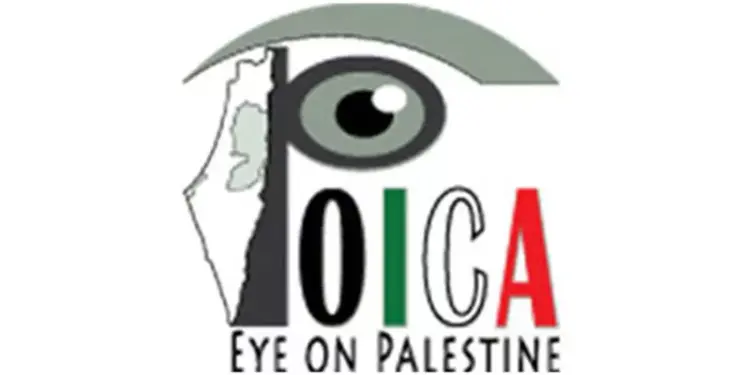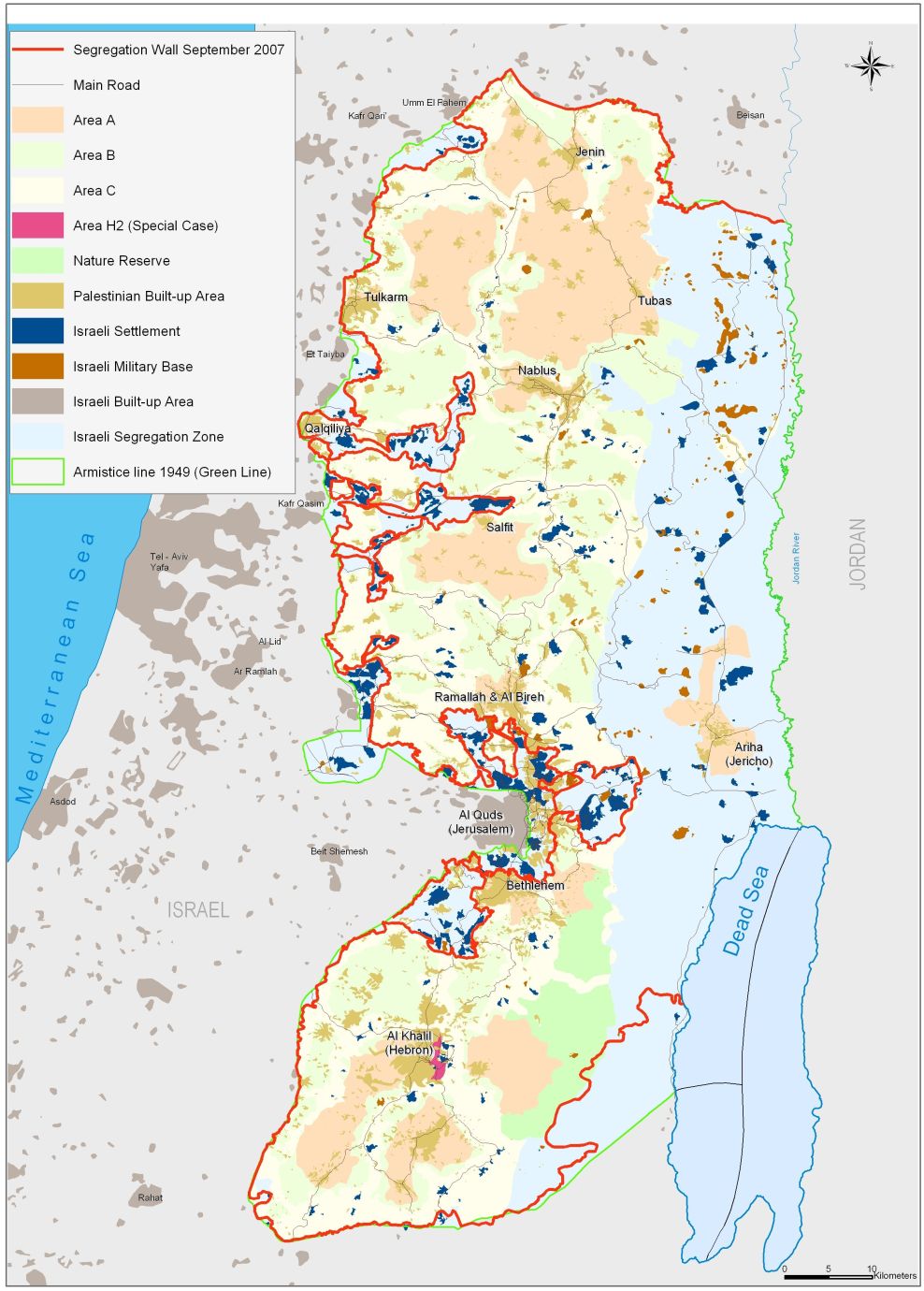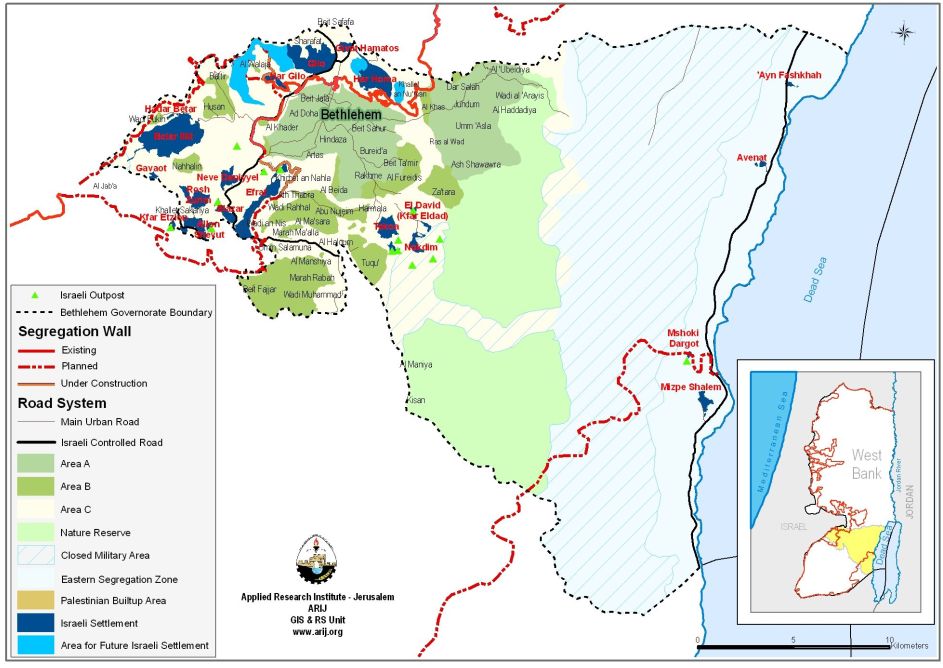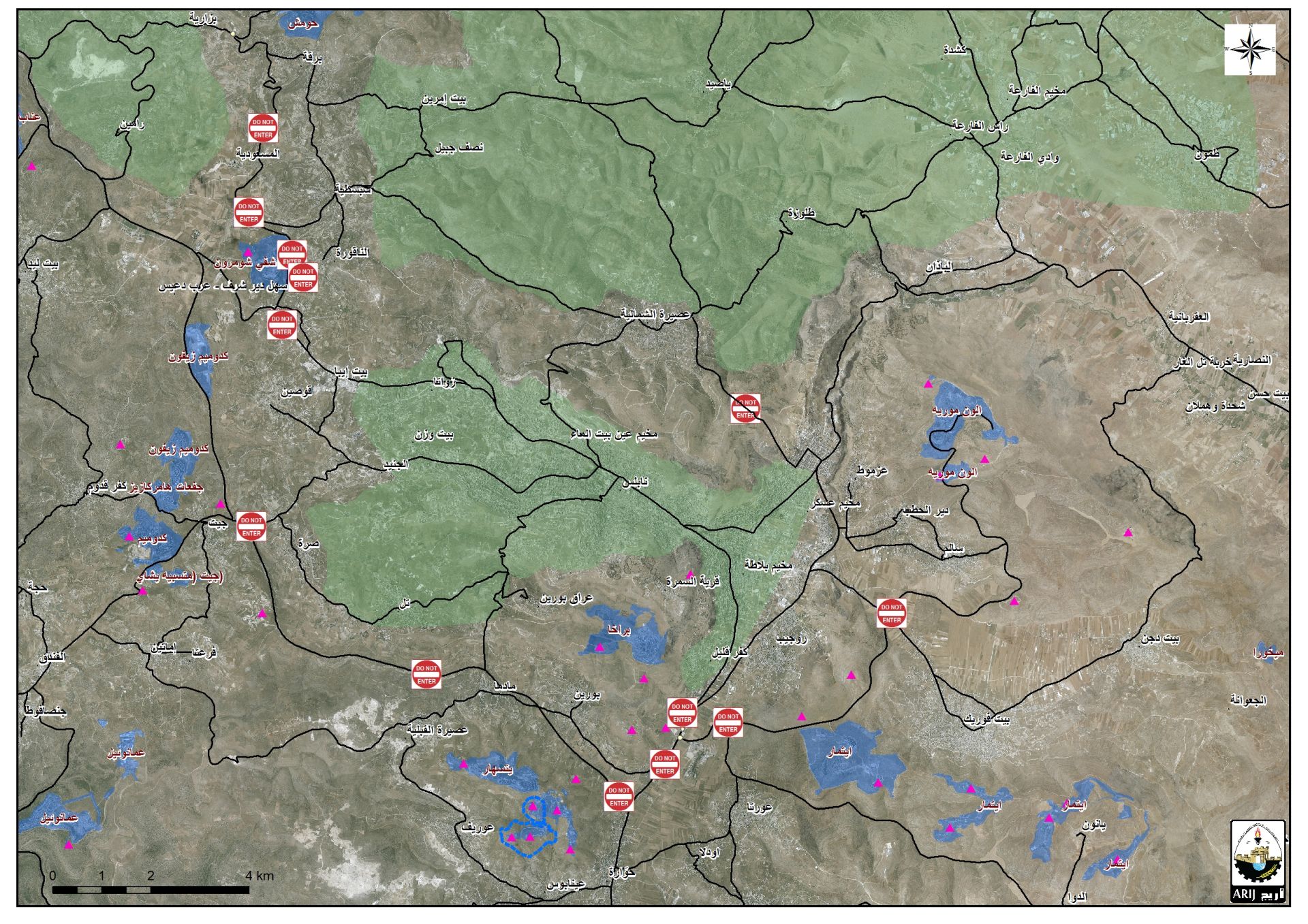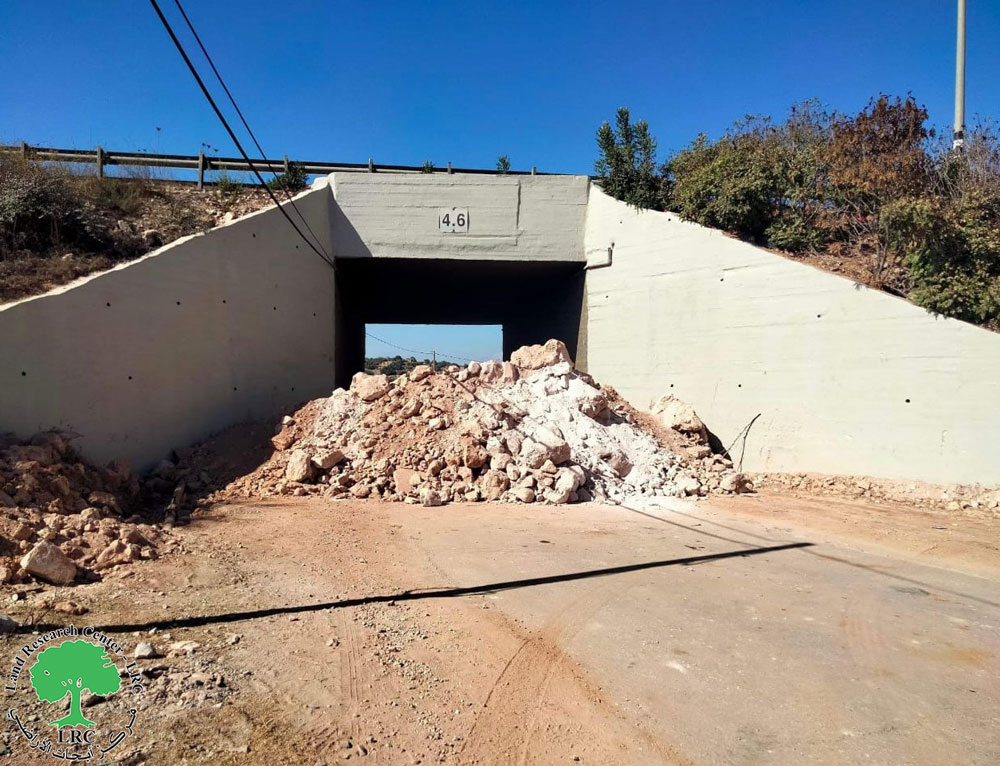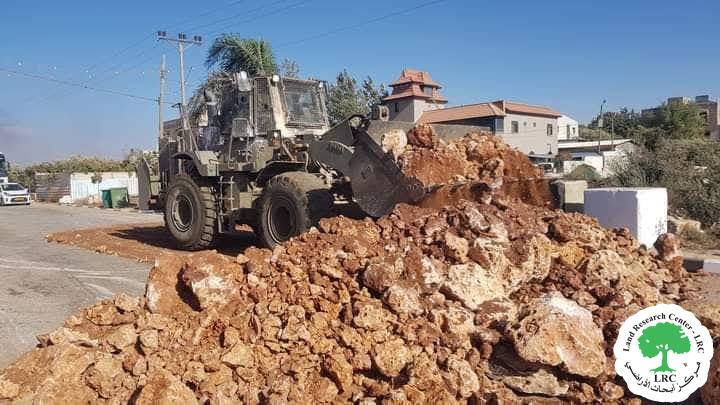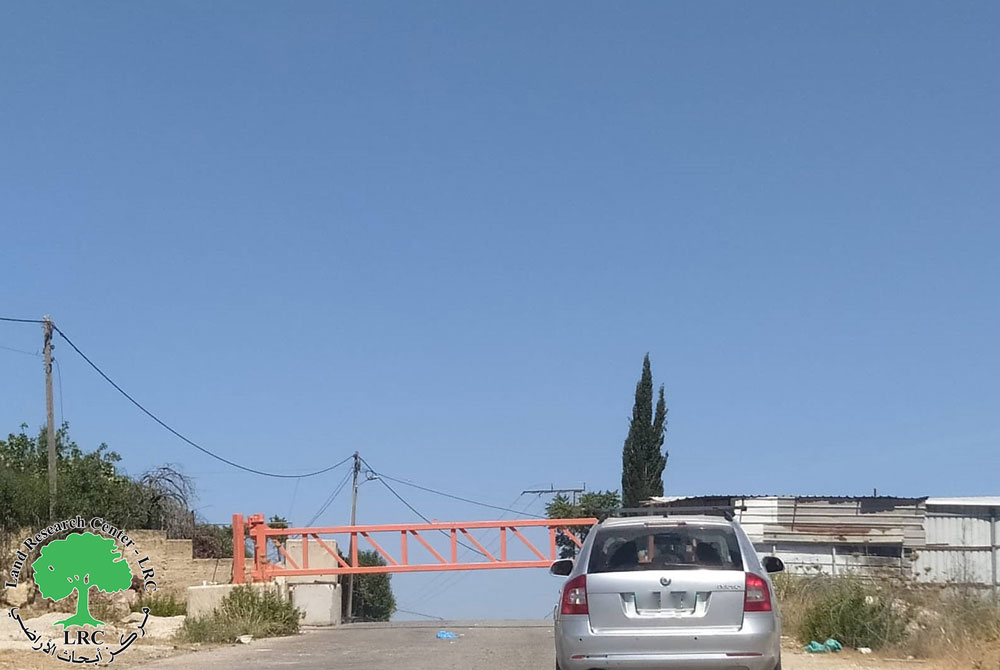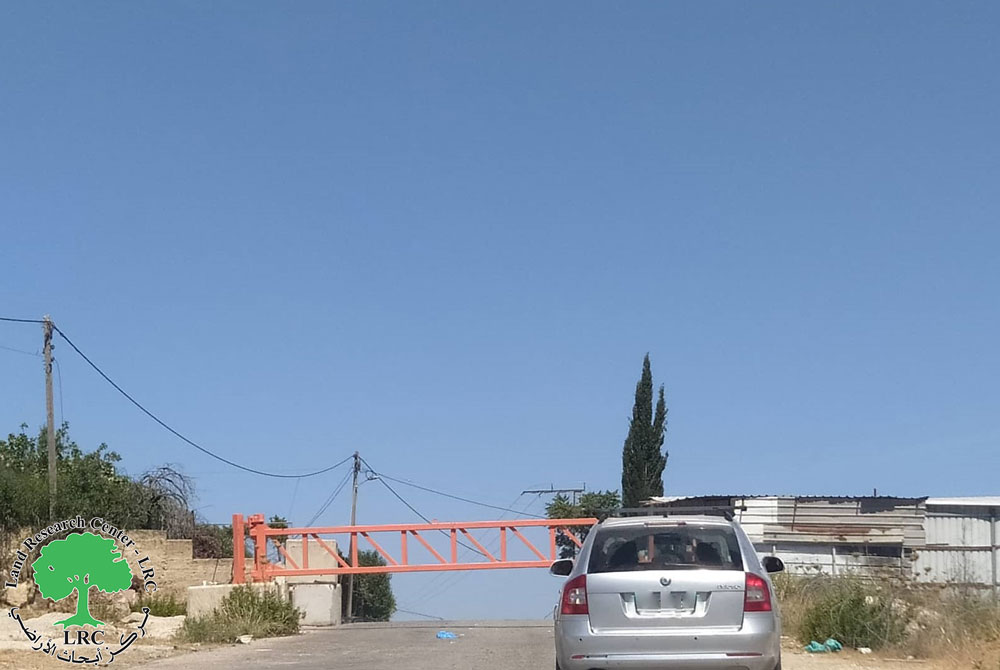The map of Israeli checkpoint stifling the daily life of more than 388 thousand Palestinians الحصار يخنق محافظة نابلس The Israeli Closure Policy in International Law The...
Read moreDetailsThe Israeli Seam Zone Permit Regime
Introduction
When Israel made the decision to begin building the separation wall in 2002, it was under the guise of security. If the true reason was for Israeli security, the wall would have been routed on the Green Line, the 1949 Armistice Line, thus allowing Israel to keep the threatening parties enclosed. Instead, 80% of the wall is built on West Bank landallowing Israel to claim lands west of the wall as there own. This area that exists between the wall and the green line is known as the seam zone.
As stated by ARIJ before, although Israel has utilized the pretext of ‘security’ to justify the construction of the Segregation Wall in the West Bank, the Wall’s path has proven to be a land grab tool that Israel used to illegally annex as many Israeli settlements as possible to Israel proper. The route of the wall is not based on actual agreed borders and lines, which leaves many Palestinians trapped in the seam zone, or separated from their families. Many, still, are separated from their land which is how they make their living. Without the unrestricted access to the land, farmers cannot tend to their crops, thus preventing income to come into the home, and further imprisoning people in the ever shrinking West Bank.
In October 2003 the Israeli Occupation Forces (IOF) distributed a military order declaring the seam zone as a closed military area. This closing affected Palestinians only, since the declaration did not apply to Israelis, settlers, or to anyone who can become IsraeliAny Palestinian living in the seam zone, or who needs access to the land must apply for a permit. Unfortunately, the application process is not a clear process, and at times obtaining a permit is not enough to access the land. The permit regime is yet another daily reminder of the occupation that the Palestinians live under.
Permit Regime Implications
This permit regime adds to the already restricted movement that exists in the occupied West Bank. According the 2005 UN report Humanitarian Impact of the West Bank Barrier on Palestinian Communities the seam zone “constitutes some of the most fertile in the West Bank. It is currently the home for 49,400 West Bank Palestinians living in 38 villages and towns”. Creating the seam zone into a closed military zone is stealing people’s livelihood and home.
The majority of the people who live in the seam zone, and who need access to their lands there are highly dependent on agricultureCreating the seam zone, taking peoples’ land and livelihood is not a security measure. It is impossible for a single person to care crops and land alone. Often times the land owner is an 80 year old man, and a permit is granted to him and no one else. This deems his permit useless since he can not harvest by himself.
Even with the permit, the final word comes from the IOF soldier that is at the gate when the Palestinian is trying to get through. Some of the gates have specific opening hours and seasons. Seasonal gates allow the farmer access to their land only during the season of the crop. This only allows for harvesting of the crop, not tending or year round care plants need. This makes the personal connection one may have with the land non existent, one cannot be a human and sit to have cup of tea under their olive tree, its only business. Even though the Israeli authorities issued additional permits and opened dozens of “seasonal gates” for the olive harvest season that started in October, the productivity of groves located behind the Wall was hindered due to the lack of access throughout the year Map 1
Map 1: The Israeli Segregation Wall plan in the Occupied West Bank
Following the completion of the wall, the permit regime will apply to an area encompassing 325,000 dunams of land (5.9% of the West Bank), and 238,000 Palestinians will be trapped in enclaves created by the wall When orders were first put out, the IOF put out material stating that that since the wall is for security purpose, then Palestinians would not be affected too severely. “The design, construction and operation of the Security Fence aim to balance the imperative to protect innocent lives from terror with the humanitarian needs of the local Palestinian population”. The website goes to further explain that state land will be used to build the wall, and that an “attempt has been made to avoid separating landowners from their lands”. This is not the reality, and the permit regime only makes the reality more difficult.
Those who live in the seam zone must have a permit as well to remain in their home. However, the permit regime ONLY applies to Palestinians. It turns the Palestinian inhabitants of the zone into prisoners in the web of requirements and the need for permits for every single move, while the Jewish inhabitants of the zone are free to move about in and out of the zone as they please, without any restrictions.
Permit Application
Depending on who the individual is, different documents are requested when applying for the permit. Before even applying for the permit, a Palestinian must qualify to apply. This means a security check and clearance must first occur. Security clearance is a confidential process, therefore no reason is given if the individual does not pass the security check.
Once the security clearance is obtained, a magnetic card is issued. The magnetic card is an ID card containing personal identification information. Although the card is valid for four years, it must be renewed every two, adding to the mountain of bureaucracy and occupational force that exists in the daily life of a Palestinian. Once the magnetic card is received then the application for a permit can begin.
When trying to find statistics on the number of Palestinians applying for a permit, it is hard to truly find the numbers. Not all magnetic card applicants receive a card; therefore those who have no magnetic card cannot even apply for a permit, so the numbers of applicants is already inaccurate.
When applying, the land owner must submit an Ichraj Qeed, which is a document proving land ownership. Each person trying to gain access must apply separately, even if it is members of the same family trying to gain access to the same land. This can be problematic since often times the land is inherited, so the name on the deed is in the name of the original owner. This turns into a battle of trying to prove blood lines and does not always come out in favor of the applicant. A Tabo registry, if it exists, is asked for[. Tabo is the land registry and is rarely submitted since most of the lands are not registered with the Tabo, not all property in Israel is registered with the Tabo.
If the person applying for the permit is an employee of a land owner, he/she must present a job contract, a document from the employer and an attorney’s declaration.
Unfortunately, the actual obtaining of the permit is not this cut and dry. Reasons for denying an application include security reasons, and insufficient documentation. These are often vague, and when an application does get rejected it is not accompanied with an explanation. There are cases of ‘lost’ applications, where the applicant has to start from scratch to gain a permit. There are also cases where applicants are turned away and asked to come another day to submit the application. So much of the application process, as well as the actual access to the land, is arbitrary and inconsistent.
Obtained Permit ? Land Access
Once the permit is obtained, things still do not run smoothly. Every person must apply for a permit separately. In the end, even with all the papers in order, when a Palestinian arrives at the gate access may be denied if the IOF solider feels like denying access. Occupation is not about laws and fair treatment, and throughout this occupation Israel has proven time and again that legality is not something they particularly abide by.
There are instances where a shepherd who is not granted access since he has a permit, but his sheep do notA separate permit is required for tractors and other farming vehicles, which makes it impossible to work the land if the individual does not receive a permit for the vehicles.
This can be seen a strategic granting of permits. When permits are granted and statistics are tallied, the numbers do not communicate who the permit actually went to or the obstacles that were presented in order to gain that permit. When permits are granted to those individuals who cannot tend their land alone will not be able to tend the land. This makes it seem as if Palestinians do not care for the land, and will leave it fallow. Numbers do not always communicate reality.
Many farmers can not even get the money to buy new plastic to cover their greenhouses. Three years of closures, added transportation costs because 90 percent of the old access roads have been cut off by the wall, difficulties in bringing in their harvests because of restrictive rules, harassment by Israeli security forces–all this has left the farmers with little money. Shareef Omar, a large landowner, will have to come up with $8,000 to pay back taxes on his 175 dunams, a sum he doesn’t have. He says many farmers will be forced to sell some of their lands in order to pay the taxes. As of February 4, only three farmers had managed to fill all the requirements and get permits to go to their land.
Dangers of Permits
The occupation that exists in the Palestinian territories is obvious. As the international community stands by, the implications of permits and the occupational system can slowly get worse.
Genocide Watch, a non-profit based in Washington DC lists common stages of genocide so that the organization can raise awareness and influence public policyWhile the situation in Palestine is not to the degree of genocide, there are eight stages of genocide that show danger and these signs do eventually lead up to genocide. The purpose of the stages is to monitor conflicts and ensure that future genocides do not occur.
The first stage is classification. There are clear racial divides, Palestinian and Israeli, and having permits and magnetic cards only makes this divide more obvious. It not only creates the divide racial, but through privilege, access, resources, and movement. The divide can also be seen as the occupied and the occupier, and those in power make it all too obvious who is in control.
These forms of identification also take it into the second stage which is symbolization. The symbols are assigned to the Arabs by the Israelis, and while they are not something sewn onto their sleeve, the concept of ID cards and flying checkpoints make Palestinians more vulnerable. This permit regime in the seam zone, where Palestinians have to further prove who they are, only cements the symbolization stage. While certain symbols are not outlawed, those with out the ‘appropriate’ symbols are not allowed through checkpoints and gates.
The third stage of dehumanization is all too evident with the checkpoints. Palestinians are herded into ‘terminals’ and the pace the people move through the checkpoint is at the whim of the IOF soldiers. The implementation of the permit regime does not take the human aspect into consideration. People make their livelihood through agriculture, if a person whose family has been farming through the generations cannot access their land, they cannot appropriately sustain themselves. The permit regime creates unnecessary and inhumane obstacles that clearly communicate that Israeli livelihood and security is more important than that of the Palestinians. The dehumanization also exists; in that, many Israelis never have to really encounter a Palestinian. On the western side of the wall, there are many cities that are completely separated from Palestinians and all things associated with the occupation.
The fourth stage is organization. The IOF illustrates this stage with out any further explanation. The fifth stage is polarization, and where the conflict finds itself. The permit regime only deepens the divide between the two parties.
Obstacles Other than the Permits
Expanding settlements that are surrounding and slowly taking over the villages serve as an obstacle and are one of the main reasons the permit regime in the seam zone is even present. People have permits to live in the seam zone may not be at peace. There is also the issue of settlement violence. Settlers who feel they have more of a right to be in the area, harass resident and even uproot crops such as olive trees.
In a conversation with a Walajeh resident who had 88 olive trees torn down, he shared stories of settlement harassment. The region of Walajeh is still not under the permit regime because the wall is still in the process of being built around the village. If the protests that are occurring in Walajeh are unsuccessful, the people will be separated from their land and will become apart of the permit regime to gain access to their crops. There are also tales of permit bribes. IOF offer permits and less restricted movements to Palestinians who give up their land willingly, or who cooperate with the process
Many villages through out the oPT have found themselves involved in nonviolent protests against the route of the wall going through their village. Masara, a village near the wall that has been protesting because the wall will separate them from their prime agricultural land and critical natural water resources are being stolen, and further isolates them along with economic livelihoods
If someone does not get a permit, or does not receive the necessary permits to work their land, the land is at a risk. Israel still implements an Ottoman old law where if private land is not sown for three years, it then belongs to the state.
A Closer Look
If the Bethlehem municipality is looked at in the map below, the red line clearly shows the route of the wall. The Green Line follows the western dotted line that marks the Bethlehem municipality boundary. The enclosed red circle where the Gush Etzion settlement block exists, and expands, is taking over the land where Palestinian villages are. To the north Gilo and Har Homa are doing the same thing. The wall and the permit regime make it easier for these settlements to exist and expand. By making it more difficult for the Palestinians to get to their land, thus making it state land, which is then used for settlement expansion. It is not a matter of security, and further illustrates the dehumanization of the permit regime. Palestinians live on the land that is being taken away, because the quality of life of the settler is more important. The expansion of Israeli land is more important than the life of a Palestinian who lives there. Map 2
Map 2: The Israeli Segregation Wall plan in Bethlehem Governorate
In the Bethlehem rural areas, the same area the Gush Etzion block covers, there are a total of 21,002 Palestinians living on 2326 dunams of the 69,719 dunams that are in the area. That is 3% of the area. While the settlement block covers 12,705 dunams, which is about 18% of the area]. The settlements continue to grow, despite the alleged freeze that had been agreed on.
In 2003 in Nahhalin, a village in the Bethlehem seam, there were 36 dunams of razed land which took out about 500 olive trees to make room for settlement expansionAlthough at that time the permit regime was not in operation in this area, and today in 2010 it is still not implemented throughout Bethlehem, these are actions that are preparing for the regime to come to the villages. The razing of land and uprooting of crops is something no permit can stop.
Conclusion
The permit regime is a slippery topic to follow. Numbers are hard to find and follow because they get lost through the cracks, or simply not counted. Through countless phone calls to various municipalities within Bethlehem, and because of middlemen involved in the permit regime, as well as the overall ‘security’ affiliated with the regime, getting a straight answer is difficult.
The wall continues to be erected, despite the clear human rights violations that are affiliated with it. The wall and the settlements are strategic land grab methods, which makes the West Bank resemble a piece of swiss cheese more than a state. Everyone has a right to security and life. Walls, permits and occupation are not the way to such rights.
[1] Canadians for Justice and Peace in the Middle East. “Factsheet: The ‘Seam Zone’- Israeli Land Grab. June 2008.
[2] Military Order Judea and Samaria no.370 http://www.taayush.org/new/regulations2.pdf
[3] p.39
[4] UN Office for the Coordination of Humanitarian Affairs “The Barrier Gate and Permit Regime Four Years On: Humanitarian Impact in the Northern West Bank” November 2007
[5] OCHA, 2009.
[8] ibid
[9] Personal correspondence with Hamoked: Center for the Defence of the Individual. June 2010.
[10] Dr. Haim Katz. Buying Your Home in Israel. Pg 20. 2007.
[14] Personal conversations July 2, 2010.
[16] Palestinian Central Bureau of Statistics, 2007.
Prepared by

